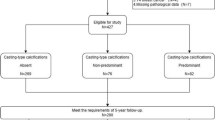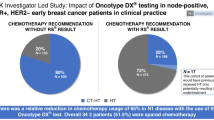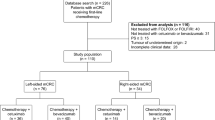Abstract
Data from basic research suggests that amplification of the proto-oncogene c-myc is important in breast cancer pathogenesis, but its frequency of amplification and prognostic relevance in human studies have been inconsistent. In an effort to clarify the clinical significance of c-myc amplification in breast cancer, we conducted a comprehensive literature search and a meta-analysis in which 29 studies were evaluated. The weighted average frequency of c-myc amplification in breast tumours was 15.7% (95% CI = 12.5–18.8%), although estimates in individual studies exhibited significant heterogeneity, P<0.0001. C-myc amplification exhibited significant but weak associations with tumour grade (RR = 1.61), lymph-node metastasis (RR = 1.24), negative progesterone receptor status (RR = 1.27), and postmenopausal status (RR = 0.82). Amplification was significantly associated with risk of relapse and death, with pooled estimates RR = 2.05 (95% CI = 1.51–2.78) and RR = 1.74 (95% CI = 1.27–2.39), respectively. This effect did not appear to be merely a surrogate for other prognostic factors. These results suggest that c-myc amplification is relatively common in breast cancer and may provide independent prognostic information. More rigorous studies with consistent methodology are required to validate this association, and to investigate its potential as a molecular predictor of specific therapy response. © 2000 Cancer Research Campaign http://www.bjcancer.com
Similar content being viewed by others
Article PDF
Change history
16 November 2011
This paper was modified 12 months after initial publication to switch to Creative Commons licence terms, as noted at publication
References
Adnane J, Gaudray P, Simon MP, Simony-Lafontaine J, Jeanteur P and Theillet C (1989) Proto-oncogene amplification and human breast tumor phenotype. Oncogene 4: 1389–1395
Alitalo K, Schwab M and Lin CC (1983) Homogeneously staining chromosomal regions contain amplified copies of an abundantly expressed cellular oncogene (c-myc) in colon carcinoma. PNAS 80: 1707–1711
Berns EMJJ, Klijn JGM, van Puten WLJ, van Staveren IL, Portengen H and Foekens JA (1992 a) C-myc amplification is a better prognostic factor than HER2/neu amplification in primary breast cancer. Cancer Res 52: 1101–1113
Berns EMJJ, Klijn JGM, van Staveren IL, Portengen H, Noordegraaf E and Foekens JA (1992 b) Prevalence of amplification of the oncogenes c-myc, HER2/neu, and int-2 in one thousand human breast tumors: Correlation with steroid receptors. Eur J Cancer 28: 697–700
Bieche I, Champeme MH and Liderau R (1994) A tumor suppressor gene on chromosome 1p32-pter controls the amplification of MYC family genes in breast cancer. Cancer Res 54: 4274–4276
Bonilla M, Ramirez M, Lopez-Cueto J and Gariglio P (1988) In vivo amplification and rearrangement of c-myc oncogene in human breast tumors. J Natl Cancer Inst 80: 665–671
Borg A, Baldetorp B, Ferno M, Olsson H and Sigurdsson H (1992) c-myc is an independent prognostic factor in postmenopausal breast cancer. Int J Cancer 51: 687–691
Breslow NE and Day NE (1987) Statistical methods in cancer research, Vol II. IARC Scientific Publication 94–2789, pp 110–112. IARC: Lyon, France
Brouillet JP, Theillet C, Maudelonde T, Defrenne A, Simony-Lafontaine J, Sertour J, Pujol H, Jeanteur P and Rochefort H (1990) Cathepsin D assay in primary breast cancer and lymph nodes: Relationship with c-myc, c-erbB-2, and int-2 oncogene amplification and node invasiveness. Eur J Cancer 26: 437–441
Champeme MH, Bieche I, Hacen K and Lidereau R (1994) Oncogene amplification per se: an independent prognostic factor in human breast cancer. Mol Carcinog 11: 189–191
Cline M, Battifora H and Yokota J (1987) Proto-oncogene abnormalities in human breast cancer: Correlations with anatomic features and clinical course of disease. J Clin Oncol 5: 999–1006
Contegiacomo A, Pizzi C, Demarchis L, Alimandi M, Delrio P, Dipalma E, Petrella G, Ottini L, French D, Frati L and Bianco AR (1995) High cell kinetics is associated with amplification of the Int-2, Bcl-1, Myc and ErbB-2 protooncogenes and loss of heterozygosity at the DF3 locus in primary breast cancers. Int J Cancer 61: 1–6
Courjal F, Cuny M and Simony-Lafontaine J (1997) Mapping of DNA amplification at 15 chromosomal localizations in 1875 breast tumors: Definition of phenotypic groups. Cancer Res 57: 4360–4367
Dalla-Farera R, Wong-Staal F and Gallo RC (1985) One gene amplification in promyelocytic leukaemaia cell line HL-60 and primary leukaemic cells of the same patient. Nature 299: 61–63
Dang CV (1999) C-myc target genes involved in cell growth, apoptosis, and metabolism. Mol Cell Biol 19: 1–14
Dickersin K and Berlin JA (1992) Meta-analysis: state-of-the-science. Epidemiologic Rev 14: 154–176
Edwards PA, Ward JL and Bradbury JM (1988) Alteration of morphogenesis by the c-myc oncogene in transplants of mammary gland. Oncogene 2: 407–412
Escot C, Theillet C, Linderiau R, Spyratos F, Champeme MH, Gest J and Callahan R (1986) Genetic alteration of the c-myc protooncogene (MYC) in human primary breast carcinomas. Proc Natl Acad Sci USA 83: 4834–4839
Fleiss JL (1981) Statistical methods for rates and proportions. John Wiley and Sons: New York
Garcia I, Dietrich PY, Aapro M, Vauthier G, Vadas L and Engel F (1989) Genetic alteration of c-myc, c-erbB-2, and c-Ha-ras protooncogenes and clinical associations in human breast carcinomas. Cancer Res 49: 6675–6679
George SL and Desu MM (1974) Planning the size and duration of a clinical trial studying the time to some critical event. J Chronic Dis 27: 15–24
Guerin M, Barrois M, Terrier MJ, Spielmann M and Riou G (1988) Overexpression of either c-myc or c-erbB-2/neu proto-oncogenes in human breast carcinomas: correlation with poor prognosis. Oncogene Res 3: 21–31
Harada Y, Katagiri T, Ito I, Akiyama F, Sakamoto G, Kasumi F, Nakamura Y and Emi M (1994) Genetic studies of 457 breast cancers, clinicopathologic parameters compared with genetic alterations. Cancer 74: 2281–2286
Hayes DF, Trock B and Harris AL (1998) Assessing the clinical impact of prognostic factors: when is ‘statistically significant’ clinically useful?. Breast Cancer Res Treat 52: 305–319
Janocko LE and Lucke JF (1995) Assessing sequential oncogene amplification in human breast cancer. Cytometry 21: 18–22
Jenkins RB, Qian J, Lieger MM and Bostwick DG (1997) Detection of c-myc oncogene amplification and chromosomal anomalies in metastatic prostatic carcinoma by fluorescence in situ hybridization. Cancer Res 57: 524–31
Kleinbaum DG, Kupper LL and Morgenstern H (1982) Epidemiologic Research, p 359. Van Nostrand Reinhold Co: New York
Kreipe H, Fischer L, Felgner J, Heidorn K, Mettler L and Parwaresch R (1993) Amplification of c-myc, but not c-erbB2 is associated with high proliferative capacity in breast cancer. Cancer Res 53: 1956–1961
Leder A, Pattengale PK, Kuo A, Stewart T and Leder P (1986) Consequences of widespread deregulation of the c-myc gene in transgenic mice: multiple noeoplasms and normal development. Cell 45: 485–495
Little CD, Nau MM and Carney DN (1985) Amplification and expression of the c-myc oncogene in human lung cancer cell lines. Nature 306: 194–196
Lonn U, Lonn S, Nilsson B and Stenkvist B (1995) Prognositic value of the erbB-2 and myc amplification in breast cancer imprints. Cancer 75: 2681–2687
Mertens F, Johansson B, Hoglund M and Mitelman F (1997) Chromosomal imbalance maps of malignant solid tumors: a cytogenetic survey of 3185 neoplasms. Cancer Res 57: 2765–2780
Meyers S, O'Brien M, Smith T and Dudley J (1990) Analysis of the int-1, int-2, c-myc, and neu oncogenes in human breast carcinomas. Cancer Res 50: 5911–5918
Munzel P, Marx D, Kochei H, Schauer A and Bock KW (1991) Genomic alterations of the c-myc proto-oncogene in relation to the overexpression of c-erbB-2 and KI-67 in human breast and cervix carcinomas. J Cancer Res Clin Oncol 117: 603–607
Nagayama K and Watatani M (1993) Analysis of genetic alterations related to the development and progression of breast carcinoma. Jpn J Cancer Res 84: 1159–1164
Nass SJ and Dickson RB (1997) Defining a role for c-myc in breast tumorigenesis. Breast Cancer Res Treat 44: 1–22
Ottestad L, Andersen T, Hesland J, Skrede M, Tveit K, Nustad K and Borresen AL (1993) Amplification of c-erbB-2, int-2 and c-myc genes in node-negative breast carcinomas. Acta Oncologica 3: 289–294
Prados J, Melguizo C, Fernandez A, Aranega AE, Alvarez L and Aranega A (1996) Inverse expression of mdr 1 and c-myc genes in a rhabdomyosarcoma cell line resistant to actinomycin D. J Pathol 180: 86–89
Riva-Lavielle C (1994) Drug resistance, oncogenes, and anti-oncogenes in epithelial tumours. Bull Cancer 81: 105s–111s
Roux-Dosseto M, Romain S, Dussault N, Desideri C, Piana L, Bonnier P, Tubiana N and Martin PM (1992) C-myc gene amplification in selected node-negative breast cancer patients correlates with high rate of early relapse. Eur J Cancer 28A: 1600–1604
Scorilas A, Yotis J, Gouriotis D, Keramopoulos A, Ampela K, Trangas T and Talieri M (1993) Cathepsin-D and c-erb-B2 have an additive prognostic value for breast cancer patients. Anticancer Res 13: 1895–1900
Scorilas A, Yotis J, Stravolemos K, Gouriotis D, Keramopolous A, Ampela K, Talieri M and Trangas T (1995) c-erbB-2 overexpression may be used as an independent prognostic factor for breast cancer patients. Anticancer Res 15: 1543–1548
Sierra A, Castellsague X, Escobedo A, Moreno A, Drudis T and Fabra A (1999) Synergistic cooperation between c-Myc and Bcl-2 in lymph node progression of T1 human breast carcinomas. Breast Cancer Res Treat 54: 39–45
Soengas MS, Alarcon RM, Yoshida H, Giaccia AJ, Hakem R, Mak TW and Lowe SW (1999) Apaf-1 and Caspase-9 in p53 dependent apoptosis and tumor inhibition. Science 284: 156–159
Tavassoli M, Quirke P, Farzaneh F, Lock NJ, Mayne LV and Kirkham N (1989) C-erbB-2/cerbA coamplification indicative of lymph node metastais, and c-myc amplification of high tumor grade, in human breast carcinoma. Br J Cancer 60: 505–510
Trock BJ, Leonessa F and Clarke R (1997) Multidrug resistance in breast cancer: a meta-analysis of MDR1/gp 170 expression and its possible functional significance. J Natl Cancer Inst 13: 917–931
Tsuda H, Hirahashi S, Shiomosata Y, Hirota T, Tsugane S, Yamamoto H, Miyajima N, Toyoshima K, Yamamoto T, Yokota J, Yoshida T, Sakamura H, Terada M and Sugimura T (1989) Correlation between long-term survival in breast cancer patients and amplification of two putative oncogene-coamplification units hst-1/int-2 c-erbB-2/ear-1. Cancer Res 49: 3104–3108
Varley JM, Swallow JE, Brammar WJ, Whittaker JL and Walker RA (1987) Alteration to either c-erbB-2 (neu) or c-myc proto-oncogenes in breast carcinomas correlate with poor short-term prognosis. Oncogene 1: 423–430
Varmus HE (1984) The molecular genetics of cellular oncogenes. Annu Rev Genet 15: 553–612
Walker TL, White JD, Esdale WJ, Burton MA and De Cruz EE (1996) Tumour cells surviving in vivo cisplatin chemotherapy display elevated c-myc expression. Br J Cancer 73: 610–614
Watson PH, Safneck JR, Lee K, Dubik D and Shiu RPC (1993) Relationship of c-myc amplification to progression of breast cancer from in situ to invasive tumor and lymph node metastasis. J Natl Cancer Inst, 902–907
Watson PH, Singh R and Hole A (1996) Influence of c-myc on the preogression of human breast cancer. Curr Topic Microbiol Immunol 213: 267–283
Yamashita H, Kobayashi S, Iwase H, Itoh Y, Kuzushima T, Iwata H, Itoh K, Naito A, Yamashita T, Masaoka A and Kimura N (1993) Analysis of oncogenes and tumor suppressor genes in human breast cancer. Jpn J Cancer Res 84: 871–878
Zhou DJ, Ahuja H and Cline MJ (1989) Proto-oncogene abnormalities in human breast cancer: c-erbB-2 amplification does not correlate with recurrence of disease. Oncogene 4: 105–108
Author information
Authors and Affiliations
Rights and permissions
From twelve months after its original publication, this work is licensed under the Creative Commons Attribution-NonCommercial-Share Alike 3.0 Unported License. To view a copy of this license, visit http://creativecommons.org/licenses/by-nc-sa/3.0/
About this article
Cite this article
Deming, S., Nass, S., Dickson, R. et al. C-myc amplification in breast cancer: a meta-analysis of its occurrence and prognostic relevance. Br J Cancer 83, 1688–1695 (2000). https://doi.org/10.1054/bjoc.2000.1522
Received:
Revised:
Accepted:
Published:
Issue date:
DOI: https://doi.org/10.1054/bjoc.2000.1522
Keywords
This article is cited by
-
Integrative multi-omic sequencing reveals the MMTV-Myc mouse model mimics human breast cancer heterogeneity
Breast Cancer Research (2023)
-
Pan-cancer pseudogene RNA analysis reveals a regulatory network promoting cancer cell proliferation
Genome Instability & Disease (2023)
-
A MYC-ZNF148-ID1/3 regulatory axis modulating cancer stem cell traits in aggressive breast cancer
Oncogenesis (2022)
-
Prognostic value of glutaminase 1 in breast cancer depends on H3K27me3 expression and menopausal status
Virchows Archiv (2022)
-
Assessment of the WAP-Myc mouse mammary tumor model for spontaneous metastasis
Scientific Reports (2020)



